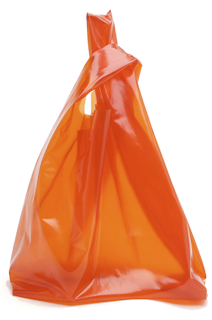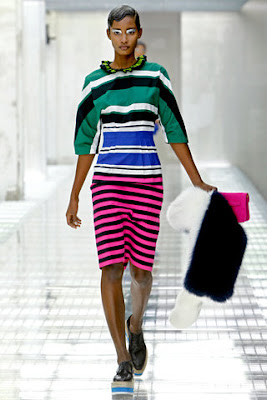AN ERA OF REDUCTONISM
The reduction of a handbag to an elemental container. Jils Sander "plastic bag" Handbag
Fashion is revealing, it is a language which tells a story about the person who wears it. "Clothes create a wordless means of communication that we all understand." Long has been said that fashion is an expression of time, and that once identified fashion begin to change, also in had with style which is what is said remains, both have brought every multicultural inspiration, ethnic, Goth, minimalism, maximalist, all together to prelude the change fashion follows. But what does Fashion tell about our times?
Since the end of the 90`s our occidental societies could be seen through a decadent prism, until everything went down with the financial recession that hit the world in 2007, the one we still getting out of and the one certainly the fashion industry was affected by, some of the great names shut down their business during this time, but many others did not. They still give what the times ask for.
The fashion industry had some names under it´s sleeve to play the game, Phoebe Philo the queen of austerity came back to fulfill the expectations, next to the longstanding ones who pursued the path of simplicity as Ms. Miuccia Prada, Jil Sander or Dries van Noten, where structure and form lead the way, the fashion industry plead to reductionism and turn towards the melting point where fashion stills a dream but next to the editorial industry principle of antireducting the idea of understated luxury, they pushed a wave of silent beauty, simplicity at it´s best, austere colors, and supreme high quality and prices kept getting higher.
By doing this the ones living under luxurious lifestyles (let´s say several houses over the world, private jets, a black car, a driver and a butler every city you go to) where able to keep spending without over showing, The reductionism era is where the maximalist ones had to turn down their decorations and detailing to invest in proportions, structures, how fabrics fall...And in the other hand minimalism, overcome in time and a very overrated term, is a new reductionism where extremely clean pieces needed some extra touches given by the search of precision, new materials and high quality reaching extremes.
Overlooking this decade reductionism tell us the story of the financial flip of the late 2000´s and open perspectives on the general idea that the greatest stuff design related has and always will be the result of reducing. Prada and the minimal baroque collection determined by reduced illustrations of cupid, monkeys and bananas next to Celine`s latest artisanal nurtured collection, both in vibrant and austere colors are the best examples of how to make people dream while creating for what our times are demanding.
Reductionism is more! (if you got what that means)
La moda es reveladora, es un lenguaje que cuenta una historia acerca de la persona que la lleva. "el vestuario crea un medio de comunicación sin palabras que todos entendemos." Se ha dicho que la moda es una expresión del tiempo, y que la moda una vez identificada comienzan a cambiar, también es el estilo el que permanece, tanto han aportado ambos, quizás cada inspiración multicultural posible, étnica, el minimalismo, gótico, maximalista, todas juntas fuentes inspiradoras son el preludio a la moda siguiente y cambiante. Pero, ¿qué dice entonces la moda de nuestro tiempo?
Desde finales de los 90 `s nuestras sociedades occidentales se podían ver a través de un prisma de decadencia, hasta que todo se fue abajo con la crisis financiera que azotó al mundo en 2007, de la que aun nos queda por salir y de la que sin duda la industria de la moda fue fue victima, algunos de los grandes nombres cerraron sus negocios durante este tiempo, pero muchos otros permanecieron. Todavía dando lo que los tiempos pedían.
La industria de la moda tenia algunos nombres bajo la manga para jugar contra los problemas: Phoebe Philo la reina de austeridad revivió, y junto a los muchos que persiguen el camino de la sencillez como la Sra. Miuccia Prada, Jil Sander o Dries van Noten, donde estructura y forma lideran el camino. La industria de la moda invoco al reduccionismo y giro hacia el punto de fusión donde la moda continua siendo un sueño, pero al lado del principio no reducido de la industria editorial que promovió la idea del lujo discreto, juntas impulsaron una ola de silenciosa belleza, la sencillez en sus mejores muestras, los colores austeros, la alta calidad suprema y… los precios seguían subiendo.
De esta manera los que viven en lujosos estilos de vida (digamos que varias casas alrededor del mundo, jets privados, un automóvil negro, un chofer y un mayordomo en cada ciudad a la que vayas ) podrían mantener su gasto sin alardear de el, La era de reduccionismo no es gratuita y es donde los maximalistas han tenido que rechazar su decoración y los detalles para invertir en las proporciones, las estructuras, como las telas caen ... Y el minimalismo por otro lado, superado ya en el tiempo y un término muy sobrevalorado, vino de mano del nuevo reduccionismo donde las piezas extremadamente limpias necesitan algunos toques extra dados por la búsqueda de precisión, nuevos materiales y el llegar a extremos de alta calidad.
Revisando esta década este reduccionismo nos cuenta la historia de la etapa financiera de finales de los años 2000 y ratifica la perspectiva general de que los mejores resultados del diseño son y siempre serán el producto de la reducción y la belleza de lo simple. Prada y la colección `mínima barroca` determinada por ilustraciones reducidas a siluetas de Cupido, de monos y plátanos junto a Celine y su nutrida colección artesanal, tambas en colores vibrantes y austeras en formas y proporciones, son los mejores ejemplos de cómo hacer soñar al mismo tiempo de crear para de lo que nuestros tiempos exigen .
La industria de la moda tenia algunos nombres bajo la manga para jugar contra los problemas: Phoebe Philo la reina de austeridad revivió, y junto a los muchos que persiguen el camino de la sencillez como la Sra. Miuccia Prada, Jil Sander o Dries van Noten, donde estructura y forma lideran el camino. La industria de la moda invoco al reduccionismo y giro hacia el punto de fusión donde la moda continua siendo un sueño, pero al lado del principio no reducido de la industria editorial que promovió la idea del lujo discreto, juntas impulsaron una ola de silenciosa belleza, la sencillez en sus mejores muestras, los colores austeros, la alta calidad suprema y… los precios seguían subiendo.
De esta manera los que viven en lujosos estilos de vida (digamos que varias casas alrededor del mundo, jets privados, un automóvil negro, un chofer y un mayordomo en cada ciudad a la que vayas ) podrían mantener su gasto sin alardear de el, La era de reduccionismo no es gratuita y es donde los maximalistas han tenido que rechazar su decoración y los detalles para invertir en las proporciones, las estructuras, como las telas caen ... Y el minimalismo por otro lado, superado ya en el tiempo y un término muy sobrevalorado, vino de mano del nuevo reduccionismo donde las piezas extremadamente limpias necesitan algunos toques extra dados por la búsqueda de precisión, nuevos materiales y el llegar a extremos de alta calidad.
Revisando esta década este reduccionismo nos cuenta la historia de la etapa financiera de finales de los años 2000 y ratifica la perspectiva general de que los mejores resultados del diseño son y siempre serán el producto de la reducción y la belleza de lo simple. Prada y la colección `mínima barroca` determinada por ilustraciones reducidas a siluetas de Cupido, de monos y plátanos junto a Celine y su nutrida colección artesanal, tambas en colores vibrantes y austeras en formas y proporciones, son los mejores ejemplos de cómo hacer soñar al mismo tiempo de crear para de lo que nuestros tiempos exigen .
El reduccionismo es más! (Si tienes lo que eso significa)
Pictures: Prada and Celine S/S 2011














Comments